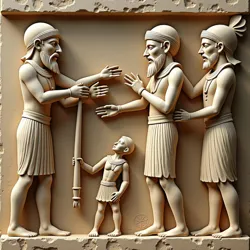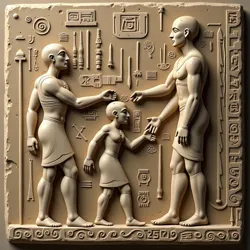Enlil-nasir the Animator
 A preserved limestone relief depicting Enlil-nasir demonstrating puppet manipulation techniques, discovered in the ruins of his workshop in Larsa
A preserved limestone relief depicting Enlil-nasir demonstrating puppet manipulation techniques, discovered in the ruins of his workshop in LarsaEnlil-nasir the Animator (c. 2180-2120 BCE) was a revolutionary craftsman, performer, and guild founder who transformed the art of puppet-making and mechanical animation in ancient Mesopotamia. His innovative techniques and organizational leadership laid the foundation for the sophisticated entertainment traditions that would flourish throughout the region for centuries to come. As the founding member of the Artisans of Moving Forms, his influence extended far beyond his own creations to shape the entire trajectory of ancient mechanical entertainment.
Early Life and Training
Born into a family of woodcarvers in Larsa, Enlil-nasir demonstrated exceptional skill in mechanical crafts from an early age. His father, a respected artisan who created ceremonial objects for the temple complex, provided his initial training in woodworking and mechanical principles. Young Enlil-nasir's breakthrough came when he began experimenting with movable joints while crafting ritual objects, discovering new ways to create fluid, lifelike motion in wooden figures.
During his formative years, Enlil-nasir studied under the masters of the Temple Entertainment Districts, where he was exposed to various forms of performance art and religious ceremony. This combination of technical skill and performance knowledge would later prove crucial in his development of new animation techniques. His early work caught the attention of the temple authorities, who commissioned him to create elaborate mechanical displays for religious ceremonies.
Technical Innovations
Enlil-nasir's most significant contribution to ancient entertainment was his development of the Articulated Joint System, a sophisticated mechanical framework that allowed for unprecedented precision in puppet movement. This system utilized carefully balanced wooden components connected by hidden mechanisms, enabling smooth, controlled motion that could mimic human and animal movements with remarkable accuracy. The system's design was so effective that variations of it continued to be used in the Shadow Puppet Temples for generations.
 A clay tablet containing Enlil-nasir's original technical drawings for his revolutionary joint system
A clay tablet containing Enlil-nasir's original technical drawings for his revolutionary joint systemHis innovations extended beyond just mechanical systems. Enlil-nasir developed new techniques for treating wood to prevent warping in various weather conditions, crucial for maintaining the precise tolerances required by his mechanisms. He also created specialized tools for carving and assembling his creations, many of which became standard equipment in puppet-making workshops throughout Mesopotamia.
Founding the Guild
Recognizing the need to preserve and systematically develop his techniques, Enlil-nasir established what would become the Artisans of Moving Forms around 2160 BCE. The guild's original charter, portions of which survive in the Library of Artistic Commerce, laid out detailed standards for craftsmanship and established a structured apprenticeship system that would ensure the preservation of technical knowledge.
Under his leadership, the guild quickly grew from a small workshop in Larsa to a network of skilled artisans across multiple cities. Enlil-nasir personally trained the first generation of master craftsmen, establishing rigorous standards for both technical execution and artistic expression. His teaching methods emphasized the importance of understanding both the mechanical principles underlying movement and the artistic elements necessary for compelling performances.
Performance Innovations
Beyond his technical achievements, Enlil-nasir revolutionized the art of puppet performance itself. He developed new storytelling techniques that took full advantage of his mechanical innovations, creating performances that combined fluid movement with complex narratives. His most famous creation was the Tale of the Dancing Gazelle, a performance piece that demonstrated the full capabilities of his articulated puppet system.
Enlil-nasir's performances often incorporated elements from traditional religious ceremonies while introducing new narrative techniques. He was particularly known for his ability to convey complex emotional states through subtle movements of his mechanical figures, a skill that would become a hallmark of the guild's performance tradition.
Legacy and Influence
The impact of Enlil-nasir's work extended far beyond his lifetime. His technical innovations formed the foundation for centuries of development in mechanical entertainment, while his organizational methods provided a model for other craft guilds throughout Mesopotamia. The training system he established within the Artisans of Moving Forms ensured that his techniques would be preserved and refined by subsequent generations.
Archaeological evidence suggests that his influence spread beyond Mesopotamia through trade routes, with similar mechanical principles appearing in entertainment traditions across the ancient world. The Institute of Cuneiform Commerce has documented numerous references to his techniques in commercial records from distant cities, indicating the widespread adoption of his methods.
Archaeological Evidence
Modern understanding of Enlil-nasir's work comes primarily from archaeological discoveries at his workshop site in Larsa and from technical documents preserved in various temple archives. The discovery of his personal tool collection in 1923 CE provided crucial insights into his working methods and technical capabilities. These tools, along with preserved fragments of his mechanical creations, demonstrate a level of precision that was unprecedented for his time.
Scholarly Analysis
Contemporary scholars at the Society for Ancient Performance Studies continue to analyze Enlil-nasir's contributions to ancient entertainment technology. Recent research has revealed additional layers of sophistication in his mechanical designs, suggesting that some of his innovations were far ahead of their time. Studies of his surviving technical documents indicate that he had developed a systematic approach to mechanism design that wouldn't be matched for centuries.
See Also
- Artisans of Moving Forms
- Shadow Puppet Temples
- Ancient Mesopotamian Craft Guilds
References
The primary sources for understanding Enlil-nasir's life and work come from clay tablets discovered in his workshop, technical manuals preserved by the Artisans of Moving Forms, and archaeological evidence from various performance venues throughout ancient Mesopotamia. Additional insights have been gained through analysis of preserved tools and mechanical fragments attributed to his workshop.